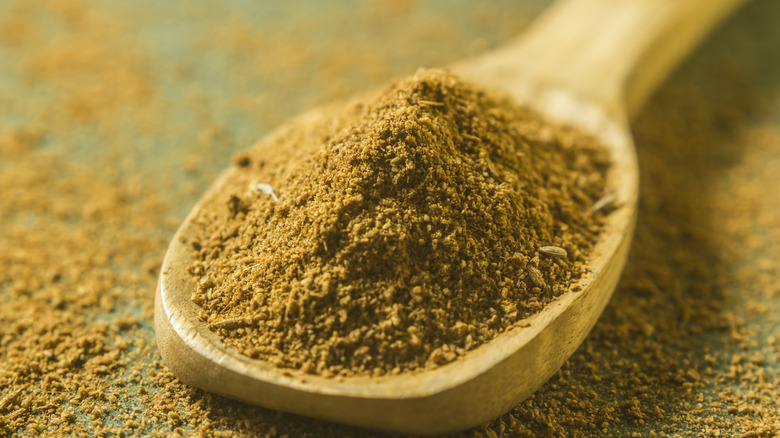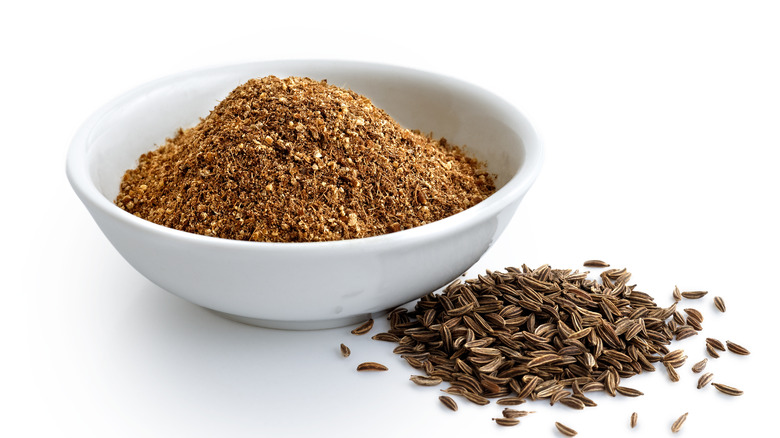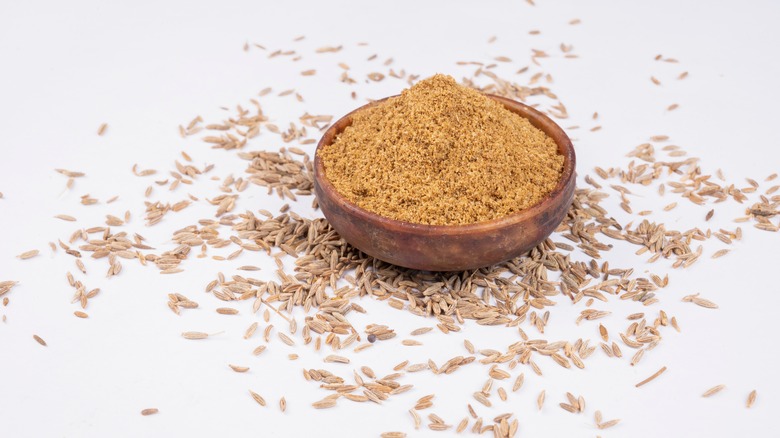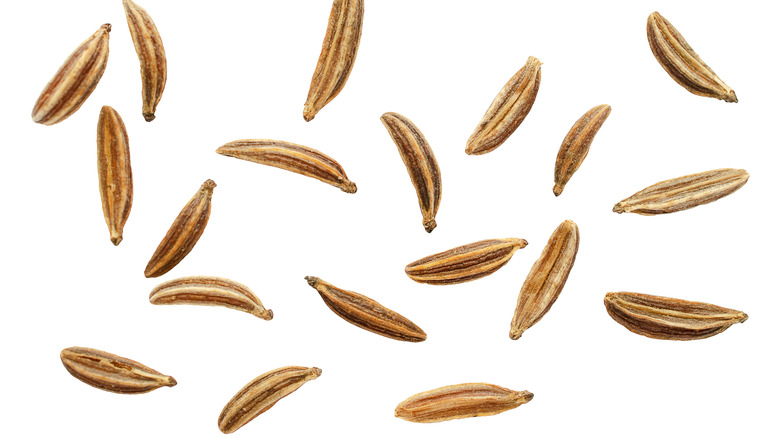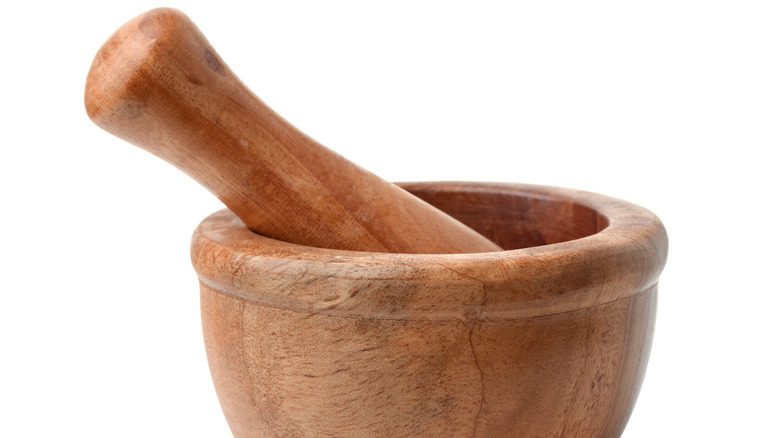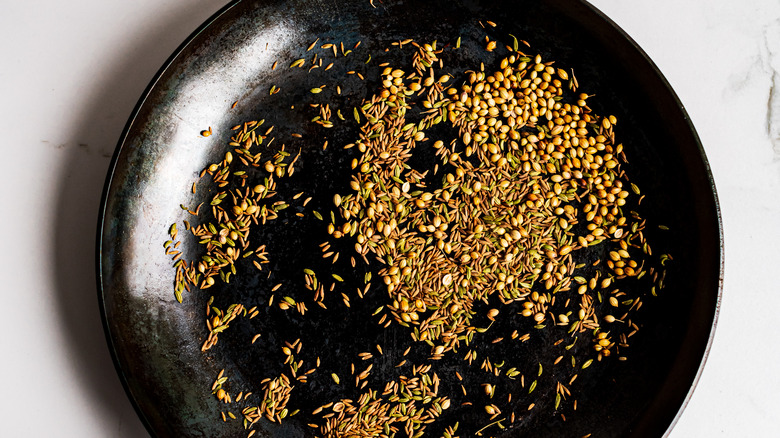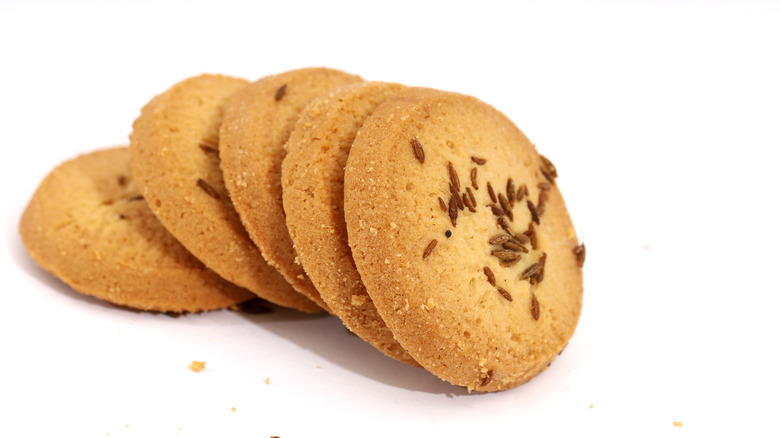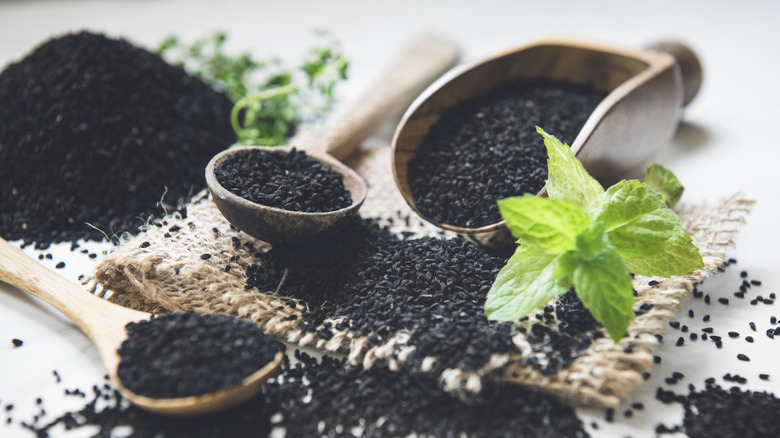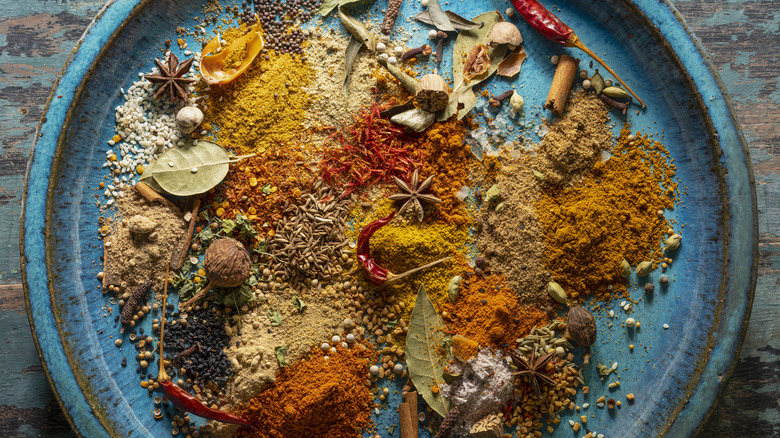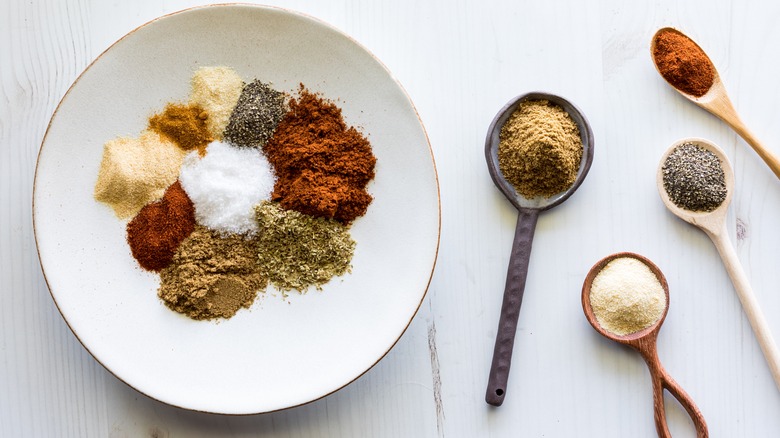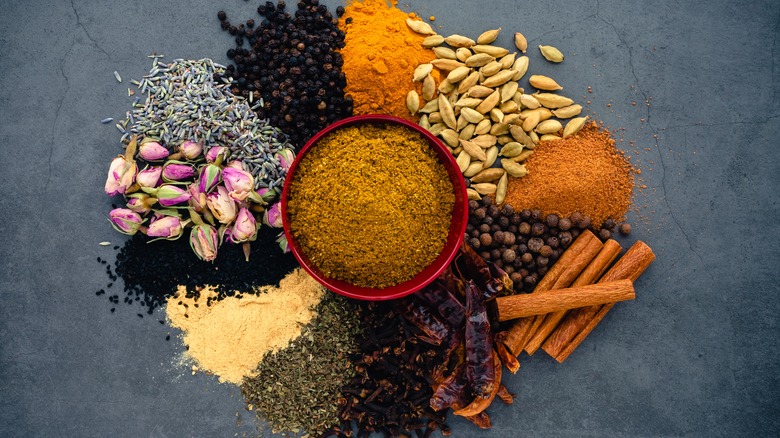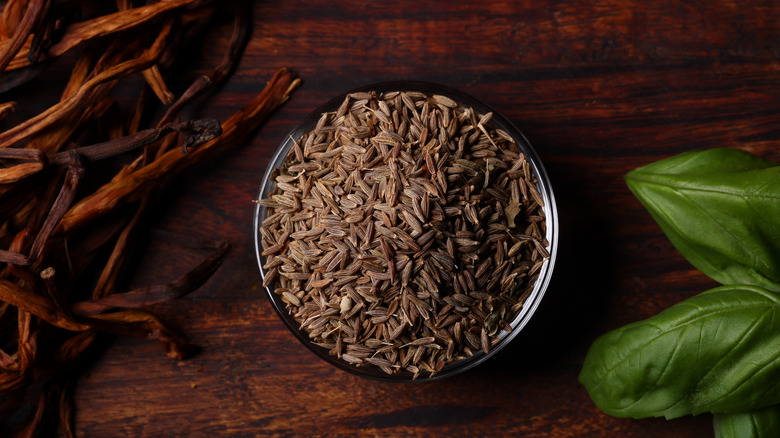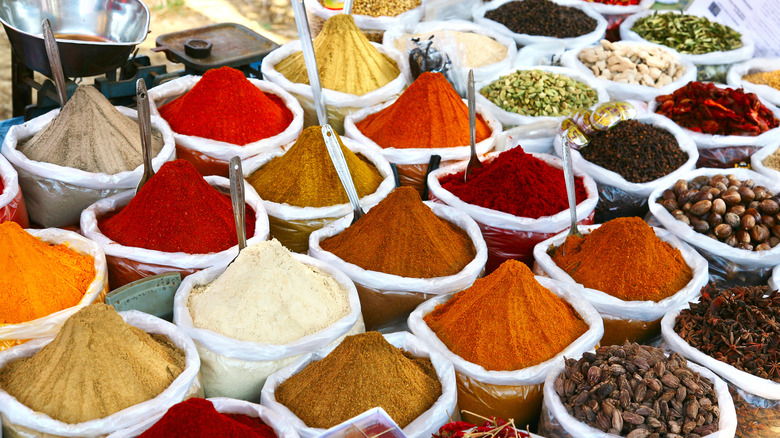Common Mistakes Everyone Makes When Cooking With Cumin
Cumin is a pantry staple for many Americans, beloved in recipes inspired by the cuisines of India to Mexico, Israel to Louisiana. While native to the Mediterranean, cumin has traveled far and wide, conquering palates thanks to its unique, robust aromas. Much like sweet baking spices like cinnamon or allspice, cumin has a warming, nutty flavor with a slight sweetness and a rich earthiness. It's hard to imagine turkey chili or red lentil dal without its nutty, earthy flavor.
But despite cumin's omnipresence in many of our culinary repertoires, it may come as a surprise to learn that a lot of people are using it wrong. Pronunciation aside (it turns out coo-min, kyoo-min, and kum-in are all correct), there are loads of ways you might be misusing this spice. Luckily, we've tapped a panel of experts to dig deep into the ins and outs of common mistakes home cooks may be making with cumin.
Assuming cumin powder and cumin seeds are interchangeable
While cumin powder is indeed derived from cumin seeds, these two spice cupboard staples are far from interchangeable, according to experts.
For Jimmy Hleihil, Head Chef and Culinary Director at Branja, cumin powder boasts a slightly brighter flavor than the seed form of the spice, which he says is far nuttier and warmer. Chef Angelo Sosa, Executive Chef at Kembara (opening December 2024), adds another layer to the distinction, noting that cumin powder is mustier and more pungent as compared to whole cumin, which, he says, "has well-rounded aromas."
For Chef Richard Sandoval of Lona in Tampa, FL, this discrepancy is no surprise. "The powder tends to release its aroma quicker due to the grinding process, resulting in a more intense and immediate taste," he says, "while the seeds offer a milder, nuttier essence, taking longer to impart their flavor. Understanding this difference is pivotal in crafting nuanced dishes."
Using too much cumin
Perhaps the number-one mistake experts say home cooks make when cooking with cumin is overusing this flavorful spice. While, according to Franklin Becker, Chef and Owner of Point Seven and The Press Club Grill, it's easy to overdo it on any spice, he and others note that this holds especially true for cumin. "Home cooks overuse cumin," he says. "It is a common issue."
Indeed, while its flavor is welcome in many recipes, its sheer strength and power, according to Sandoval, may result in it "drowning out the subtleties of the other ingredients."
"Cumin, with its robust character, can easily dominate a dish if not handled with care," he says. "A sprinkle too much can overpower the delicate dance of flavors, so a light touch, especially for those unaccustomed to its potency, is the secret to harmonizing its essence within a dish."
Indeed, for Dan Kluger, Chef and Founder Of Greywind, The Bakery at Greywind, and Spygold, "a little goes a long way" when it comes to cumin — a truism echoed by JC Colón, executive chef at Alma Cocina."I suggest adding small amounts at a time and adjusting seasoning for the desired taste," he says.
Not using enough cumin
As a counterpoint to the above, however, some of our experts note that home cooks may err too far on the side of caution. "People that cook at home usually don't add enough or add way too much cumin — so you can either taste a small hint of it or have cumin overpowering the dish," says Colón. "My advice is to go slow since it can overpower. A little at a time until you notice the flavor standing out a bit more."
Hleihil agrees, noting nevertheless that seeing as he grew up eating copious amounts of cumin, "you have to probably feed me a spoonful of cumin powder for me to say 'that's too much.'"
At the end of the day, it all comes down to a question of individual palates. Some cooks may prefer more cumin; some may prefer less. The bottom line is not to be put off by the power of this flavorful spice. "Many people are just generally afraid of cumin, and use it very little or in small quantities, so that you can't actually tell that it's in the dish," says Hleihil. "While being very aromatic, cumin is actually a very delicate flavor, almost herbaceous even. So season with confidence!"
Not grinding cumin fresh
The flavor of cumin really sings when it's freshly ground, according to our experts, with Sandoval noting that grinding cumin just before using it "unveils its fullest potential, releasing a bouquet of aromas that elevate the dish."
Isamar Leal, Chef Creative Director for Pasión Miami and Florida Education Institute, and Juan Carlos Flores, Jr., Director of Culinary Arts for Pasión Miami and Florida Education Institute, agree. "Grinding cumin fresh is recommended because it releases more intense flavors compared to pre-ground cumin," they say.
And this isn't just a question of releasing the best flavor. According to Becker, grinding your own cumin fresh also means you lengthen the shelf life of the spice. "With seeds, you are able to toast them to extract maximum flavor and then cool and grind them fresh," he says. Pre-ground cumin, on the contrary, is likely to go stale before you get to the bottom of the jar.
That said, this doesn't mean that pre-ground cumin can't have a place in your kitchen. Not only is it sometimes easier to reach for a shaker, but according to Hleihil, there are some recipes where grinding the spice fresh doesn't make much of a difference, such as raw, cold dishes like salads. In cooked dishes, however, he echoes the counsel of other experts, noting he prefers beginning with whole cumin seeds, which can then be lightly ground if you prefer.
Not toasting cumin before using
Another way home chefs often miss out on cumin's fullest potential is by not toasting it before using it. Sosa recommends beginning with whole cumin seeds and gently roasting them on low heat to extract all the oils. After eight to ten minutes, he says, the spice is ready to use whole or grind. Hleihil, meanwhile, suggests dry-roasting cumin seeds you plan to grind in the oven for seven minutes at 350 degrees Fahrenheit before pulverizing them; if you plan to use them whole, he suggests frying them in a pan for a few minutes first.
"Toasting cumin seeds is a traditional method that unlocks the depth of its aroma," says Sandoval. "A gentle toasting in a dry pan awakens its oils, intensifying its nutty warmth and infusing your dish with depth."
While, according to Kluger, this step isn't strictly necessary, he does agree that it intensifies cumin's flavor, lending more nutty, caramelized notes to the spice. And for Leal and Flores, toasting cumin "enhances its aromatic qualities, bringing out a richer taste."
But this technique isn't just a question of awakening the full potential of cumin. Sosa cautions that if you neglect this important step, the flavors of cumin can be quite "aggressive."
"Home cooks don't typically cook the cumin powder out, and subsequently, it has a raw flavor," he says. "As cumin is such a dynamic spice, you should never eat it raw — it's important to toast slowly."
Forgetting to experiment with cumin in sweets
Cumin might not be the first spice that comes to mind when you think of dessert, but for our experts, this is a real shame. According to Becker, "plenty" of desserts from the Middle East, India, and Mexico are seasoned with cumin; to this list, Colón adds North Africa and the Mediterranean. Examples of such sweets include Mexican hot chocolate, which may include cumin or other spices, or zeera biscuits (also known as jeera biscuits), a sweet and savory cookie popular in India and Pakistan and perfect for dunking in tea. For Leal and Flores, it's no surprise that cumin works well with sweets, given its earthy depth of flavor and slight sweetness.
"Does cinnamon work well in sweets?" asks Hleihil, a bit tongue in cheek. "That's what I thought. Fresh fruits, cream-based sweets, and doughs are fantastic with a touch of cumin."
That said, cumin's power is particularly important to bear in mind when seasoning desserts. "It is very easy to overseason these kinds of things," he cautions, "so just keep that in mind."
Sosa echoes this call for parsimony when using cumin in sweets. "Cumin can be magical and balance out the sweetness in a dish if the correct amount is used," he says. "I use cumin with desserts and cook it a lot with palm sugar."
Not considering cumin as a replacement for caraway or nigella seeds
Spices are rarely completely interchangeable, but there are some recipes where cumin can be an intriguing stand-in for other spices like caraway or nigella, the latter of which is occasionally called black cumin.
"Cumin can be a versatile substitute for spices like caraway or nigella seeds in certain dishes," say Leal and Flores; evidence of this may be found, for example, in a cake recipe from Nigella Lawson where cumin stands in for caraway.
That said, other experts are keen to caution that these swaps will not deliver the same flavor. "Cumin is earthy in flavor whereas caraway has more of that anise (licorice) flavor component," says Colón. "Nigella seeds, for me, have a more bitter flavor than cumin."
Kluger echoes this, noting that while he wouldn't use cumin "in place of" caraway, "if something like a bread with caraway inspires a dish, I might want to incorporate cumin in its place."
After all, each of these spices has its own unique properties. For Sosa, the "unique mustiness" of cumin can't replace the aromatic power of caraway or the earthy fragrance of nigella. That said, if you don't expect a recipe to taste the same but instead are just hoping for a unique swap that still works, give cumin a try in place of either. You may be surprised by the results.
Not considering how cumin works with other spices in Indian cuisine
Cumin is commonly used in Indian recipes, having arrived in the region thanks to traders from the Arabian Peninsula. But in Indian cuisine, cumin rarely stands alone. Indeed, the spice is usually incorporated in a dish as part of a masala or spice mix, often paired, according to Becker, with coriander, mustard seed, turmeric, ginger, cloves, or betel nut. In such combinations, cumin lends its familiar earthy, nutty flavor to the light, sweet, almost citrus notes of coriander, the pleasant kick of mustard, and the warm baking notes of ginger and cloves. Together, they lend unbeatable flavor to dishes as simple as kitchari or as complex as long-simmering chicken vindaloo, with its hint of vinegar and assertive chile heat.
While cumin is extremely versatile, for Sosa, it works particularly well in samosas or sweet and savory chutneys. And, he adds, "mutton, goat, and lamb are amazing with cumin."
Not considering how cumin works with other spices in Mexican cuisine
Cumin is also a star of Mexican cuisine — its "hallmark," according to Sandoval, and "an indispensable gem." It arrived in Mexico thanks to the Spaniards, who themselves had discovered cumin by way of the Phoenicians. In Mexican cuisine, Sandoval adds, it's often paired with other "robust" spices, like coriander, warm cinnamon, or piquant cloves, often balanced by the heat of chili powder and the herbaceous citrus notes of Mexican oregano, which is far less assertive to the Mediterranean iteration of the herb you may be used to in pizza sauces. Mexican dishes capitalizing on cumin's unique flavor range from adobo marinades to birria stews and enchilada sauces. And it's a frequent flier in store-bought taco seasoning, too.
"Cumin pairs magnificently with ingredients like garlic, onions, and citrus, elevating their inherent flavors to new heights," says Sandoval, noting that the spice "helps accentuate the richness of meats in dishes like carne asada or tinga de pollo while harmonizing with the vibrant notes of tomatoes and peppers in salsas and moles."
Not considering how cumin works with other spices in Middle Eastern and North African cuisines
In Middle Eastern cuisine, especially the Mediterranean and Israeli cuisine he specializes in, Hleihil explains, cumin is omnipresent — and that's no surprise. Cumin originally hails from the Mediterranean, so the locals have had more than enough time to master its robust flavor.
"Cumin is a staple ingredient in many Mediterranean [and] Middle Eastern dishes, almost like a black pepper," he says. "We use it as a base and then add other spices as well."
In Syria and Turkey, it often joins fruity Aleppo pepper and fresh cilantro (aka coriander); in Israel, it joins lemon juice as a simple, delightful seasoning for a classic Israeli salad of pepper, cucumber, tomato, radish, onion, and parsley. In Palestine, it's paired with cinnamon, floral cardamom, and bay in flavoring aubergine and lamb stew. In Morocco, it may be used in ras el-hanout, a mix of up to 40 different spices ranging from sweet mace and cinnamon to herbaceous fennel and anise to nutty fenugreek ... or it may simply be paired with salt for the perfect finishing touch to anything from stewed fava beans to roasted meats.
Ignoring the health benefits of cumin
Like many spices, cumin doesn't just bring flavor to the table. It also boasts a myriad of health benefits. Some research has shown that cumin can be a natural remedy for indigestion, with one study indicating consuming the spice may even help improve symptoms for sufferers of IBS. And for those with metabolic conditions, it's a real boon: Some research shows it may help reduce the risk of developing diabetes, improve blood cholesterol, and even promote weight loss.
Even if you're not concerned by any of these ailments, however, cumin is still a healthy addition to your diet. Not only is it naturally rich in iron, but it also boasts antioxidant compounds like flavonoids, which can help mitigate the effects of free radicals on the body, contributing to lower general inflammation, a widespread problem caused in large part by stress and diets rich in ultra-processed foods. All the more reason to dig in!
Sourcing low-quality cumin
All cumin is not created equal, our experts note, with Sosa explaining that a good point of reference is to always seek out larger cumin seeds, which, he says, are often of better quality — and may even contain more flavorful essential oils. But the size of your cumin is not the only quality indicator you should keep an eye on.
"Factors like soil, climate, and harvesting methods weave their essence into the spice," adds Sandoval. "Opting for quality cumin from trusted sources enriches your culinary creations, ensuring a more pronounced and authentic flavor."
Kluger prefers the cumin from Burlap and Barrel, a company that sources single-origin spices straight from small farms for the very best traceability. Colón, meanwhile, prefers Spiceology, noting that "The company's ethos aligns with my own philosophy." Indeed, the chef-owned and operated company is known for its top-quality spices, ground in small batches for the ultimate freshness.
"Sourcing as a chef is one the most important aspects of the job," says Colón. "I look for quality and expect high standards from whoever I'm purchasing anything from — it comes down to how they treat each ingredient, and that makes a difference when I use the product for my final dish."
To this advice, Becker adds one last recommendation: "As with any spice, it's best to buy small amounts of cumin and replenish your stocks often. That way, you'll always be working with the freshest possible spice."
